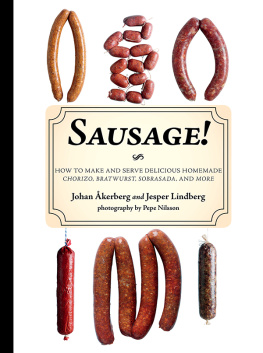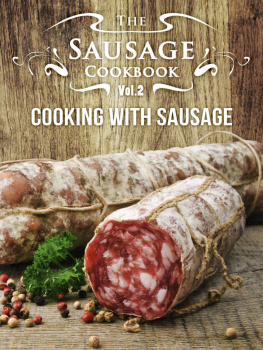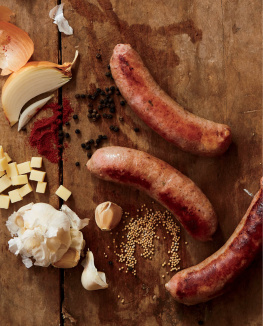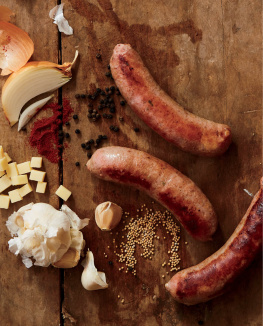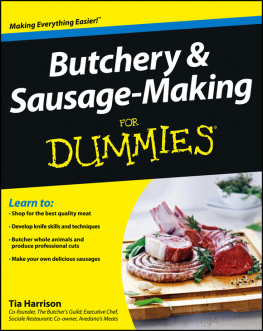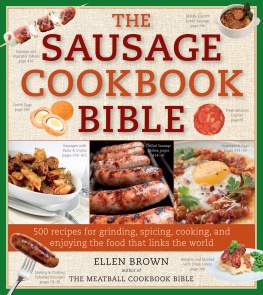Victoria Wise - Sausage: Recipes for Making and Cooking with Homemade Sausage
Here you can read online Victoria Wise - Sausage: Recipes for Making and Cooking with Homemade Sausage full text of the book (entire story) in english for free. Download pdf and epub, get meaning, cover and reviews about this ebook. year: 2010, publisher: Ten Speed Press, genre: Home and family. Description of the work, (preface) as well as reviews are available. Best literature library LitArk.com created for fans of good reading and offers a wide selection of genres:
Romance novel
Science fiction
Adventure
Detective
Science
History
Home and family
Prose
Art
Politics
Computer
Non-fiction
Religion
Business
Children
Humor
Choose a favorite category and find really read worthwhile books. Enjoy immersion in the world of imagination, feel the emotions of the characters or learn something new for yourself, make an fascinating discovery.

- Book:Sausage: Recipes for Making and Cooking with Homemade Sausage
- Author:
- Publisher:Ten Speed Press
- Genre:
- Year:2010
- Rating:4 / 5
- Favourites:Add to favourites
- Your mark:
- 80
- 1
- 2
- 3
- 4
- 5
Sausage: Recipes for Making and Cooking with Homemade Sausage: summary, description and annotation
We offer to read an annotation, description, summary or preface (depends on what the author of the book "Sausage: Recipes for Making and Cooking with Homemade Sausage" wrote himself). If you haven't found the necessary information about the book — write in the comments, we will try to find it.
Victoria Wise: author's other books
Who wrote Sausage: Recipes for Making and Cooking with Homemade Sausage? Find out the surname, the name of the author of the book and a list of all author's works by series.
Sausage: Recipes for Making and Cooking with Homemade Sausage — read online for free the complete book (whole text) full work
Below is the text of the book, divided by pages. System saving the place of the last page read, allows you to conveniently read the book "Sausage: Recipes for Making and Cooking with Homemade Sausage" online for free, without having to search again every time where you left off. Put a bookmark, and you can go to the page where you finished reading at any time.
Font size:
Interval:
Bookmark:
I ADORE Ten Speed Press, their style, their expertise, their attitude, the gorgeous books they publish, and, of course, their perspicacity in choosing to publish this one. It was especially gratifying to work with Aaron Wehner, publisher, who spotted this projects worth, and with Melissa Moore, project editor for this book, and Dawn Yanagihara, end-stage editor, both of whom are unflappably cool and collected and on top of the moment no matter the authors concern. Also, Sharon Silva, copy editor par excellence, whose keen reading saved me more than once from potential embarrassment, and Kathy Hashimoto, one of the calmest contract-department persons I have ever encountered. And, for such a beautiful book, thanks many times over to Leo Gong, Karen Shinto, Nancy Austin, and Katy Brown.
In addition, I owe thanks forever to those who bolster and encourage me and without whom I couldnt live in either my professional or personal life. Martha Casselman, my dear friend and former agent before she retired, who encouraged me to get into this crazy business of writing cookbooks and who is still at the ready to help smooth my prose in draft after draft. Susanna Hoffman, dear friend for forty years and sometimes co-author, with whom I have shared many sausage discussions as we developed cookbooks together and learned from each other. Arayah Jenanyan, my beloved sister, who has a palate uncompromised by personal preference and who, from the beginning until the day we closed the Pig, was key in making sure the meats and vegetables in the display case shined clear and fresh, as well as in keeping me and the rest of the shop focused throughout the day. James Chooch Potenziani, the master behind the art and finesse of turning out the divine sausages, pts, hams, and other charcuterie that made the Pig renowned before the word charcuterie became hip in the American food lexicon. Penny Brogden, artist and friend, who energetically lent her artistic sensibility and hands-on effort to the daily operations of making beautiful and delicious food at the Pig. This sausage cookbook has grown from all of them.
Grinding Meats and Stuffing Sausage at Home
Not all cuts of meat, whether pork, beef, lamb, or poultry, are suitable for sausage. Here are the cuts to choose for grinding at home.
Use shoulder meat, purchased either as a pork butt or pork shoulder roast or as shoulder chops. These cuts are usually trimmed by the butcher and need no further trimming. Pork tenderloin with a little added fat and the fatty ends of pork loin are also good for sausages, but the center-cut loin is not. Use a grinding plate with -inch holes. This size cuts the meat and its fat just right to make a tender sausage, without smashing either of them or cutting them too large to melt when cooked.
Look for blade roast, flatiron steak, stew meat, or cross-rib roast. All are cuts of beef chuck and have just the right ratio of meat to fat. Use a grinding plate with - or -inch holes.
The shoulder, either as shoulder roast, shoulder chops, or sirloin chops, is the most versatile cut for lamb sausage. Occasionally, as in the case of the , the leaner meat from the leg is desirable. Use a grinding plate with -inch holes.
Purchase either breast meat or thigh meat. An advantage of grinding chicken yourself is that you can include the breast skin, which adds tasty fat. Turkey breast or thigh meat is the choice for sausage making, though I seldom use either cut because turkey is so lean it is not a good candidate for sausage (see the recipe for Turkey and Pistachio Meatballs for an exception). Both chicken and turkey usually require added fat of some sort for succulence. Use a grinding plate with - or -inch holes, depending on how much texture you would like in the sausage.
See the section in the Ingredients chapter for the types of animal fats to use for sausages. For grinding, use the same-size plate as you do for the meat, and put the fat through last, so it can push out any meat left behind in the tube.
In shaping sausages, function determines form to a certain extent. That is, in terms of its substance, no difference exists between a patty and a meatball, between a tiny meatball and a large one, or between a link, a patty, and a meatball. But there is an aesthetic difference in the way the dish is perceived, and therefore in the way it is tasted. Following are the options for natural casings and a substitute that is acceptable in a pinch.
These are the intestines of pigs and sheep, respectively. Hog casing, 1 to 1 inches in diameter, is used for most sausages, such as sweet Italian, Polish, and so on. Sheep casing, about inch in diameter, is used for small links, such as little . One foot of hog casing holds 8 to 10 ounces of sausage; one foot of sheep casing holds 4 to 6 ounces. They can usually be purchased from butchers who make their own sausage, or both can be ordered on the Internet. They come in salt-encased bundles that will keep almost forever in the refrigerator. Cut off the length you are going to use and rinse thoroughly inside and out by fitting one end on the nozzle of the kitchen sink water spout and gently running water through the casing.
Also known as veil fat, caul fat is the lining of the lower stomach and upper intestine of pigs or sheep. Pork caul is traditionally used for wrapping crpinettes and pts, as well as roasts that need some moistening as they cook. Sometimes, you can find a specialty butcher who has it for house use and is happy to sell some to a customer. You can also order it on the Internet in 2- to 5-pound packages. One half pound of caul will wrap about 3 pounds of sausage in 4-ounce patties. To use caul fat, soak it briefly in lots of water, with distilled white vinegar added if necessary to whiten it, then rinse again. Unravel the caul and spread it out, taking care to handle it gently, as it is quite delicate. Store any caul you havent used in the freezer indefinitely. If thawed and not used up, caul fat can be refrozen.
For when you want links, not patties or balls, but dont have the casings or equipment for stuffing them, cheesecloth can substitute. It works, with the proviso that it does not lend the unique, desirable flavor that an animal casing does.
To make cheesecloth-wrapped links, divide the sausage mixture into 3- to 4-ounce portions. Press and roll each portion into a log to 1 inches in diameter, depending on the size you want the links. Place each portion in a length of cheesecloth large enough to enclose it, and roll it up snuggly, tucking in the ends as you go. Place the wrapped links on a plate and refrigerate for at least 4 hours; overnight is better. They will keep in the refrigerator for up to 2 days. If you are boiling or parboiling the sausages, leave them in the cheesecloth. Otherwise, unwrap them before sauting, grilling, or baking.
You will need some type of sausage-stuffing device for stuffing sausage mixtures into hog or sheep casing. Various types are available, from simple, hand-cranked countertop models to state-of-the art, highly mechanized apparatuses. When cooks routinely ground their meats and stuffed sausages at home, a hand-cranked meat grinder with a sausage stuffing attachment was part of the kitchen equipment. An electric version of that anachronistic home model makes the job easier and more fun because you dont need to struggle to push the meat through the plate or to fill the casings. For home sausage making, I use an inexpensive electric combination grinder and stuffer. The Internet is full of options in this regard, some with more horsepower, some with less, some taking up a lot of counter space, some more svelte that can be tucked away when not in use. Purchasing one is worth the modest expense if youre avid about stuffing sausages.
Font size:
Interval:
Bookmark:
Similar books «Sausage: Recipes for Making and Cooking with Homemade Sausage»
Look at similar books to Sausage: Recipes for Making and Cooking with Homemade Sausage. We have selected literature similar in name and meaning in the hope of providing readers with more options to find new, interesting, not yet read works.
Discussion, reviews of the book Sausage: Recipes for Making and Cooking with Homemade Sausage and just readers' own opinions. Leave your comments, write what you think about the work, its meaning or the main characters. Specify what exactly you liked and what you didn't like, and why you think so.

